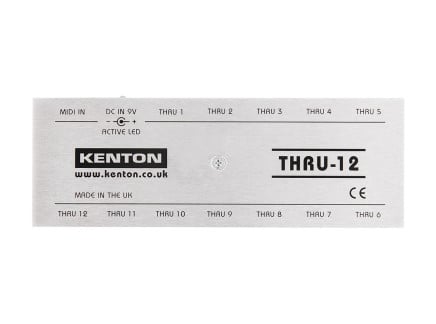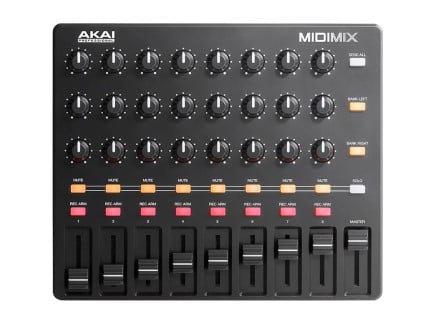It's difficult to imagine what the current landscape of electronic music would look like in a world without MIDI. Unlike the finality of an audio recording, MIDI data is much more malleable—notes, control changes, and more can be transmitted in real-time to other instruments, or captured, edited, and played back to any compatible instrument via a DAW or dedicated MIDI sequencer. MIDI is largely independent of an instrument's audio output, and simply tells an instrument what to do, when to do it, and how it should be done, allowing performances to be captured before committing to how something sounds. MIDI has come quite a long way since its conception in the early 1980s, and there are more ways than ever to connect all kinds of electronic instruments together for sequencing, parameter control, and synchronization.
Interested in finding out more about how the MIDI specification came to be? Check out our previous article titled A Brief History of MIDI to gain more insight into the rise of this clever data protocol.
It's honestly remarkable that MIDI has been around for nearly 40 years, and while it remains functionally close to its origins, it has adopted a few different physical forms in that time. To the experienced electronic musician, adapting from one type of connector to another may seem trivial, but to the uninitiated it can come across as overwhelming and complicated. Let's spend a moment breaking down each type of MIDI connector you might come across on your musical journey.
5-pin DIN: The Classic MIDI Connector
In its developmental stages, the MIDI protocol actually utilized standard 1/4" cables, exactly like those used for audio signals. But as the protocol developed, and to likely make it apparent that MIDI isn't the same thing as audio, MIDI found its home in the form of the 5-pin DIN connector.
While it tends to vary depending on the specific instrument, it's common to find three different 5-pin ports on any given synth: In, Out, and Thru. MIDI connections in this format are one-way connections, so one can logically assume the function of each port from its name. Notes and control data are transmitted from an instrument via its Out port, and connecting that to another device's In port will cause it to listen to that data and respond accordingly. For controlling multiple instruments at once, utilizing the Thru port will pass incoming MIDI data from the In port on to another connected device.
It's worth remembering that the origins of MIDI somewhat predate the rise of the personal computer, at least for most people. At this point in time, the largest appeal was the ability to play one instrument all the way on the other side of your studio from the keyboard that was sitting right in front of you. As you might imagine, connecting two synthesizers can be relatively simple, but adding in additional pieces to your setup quickly introduces more possibilities,and results in the need for creative problem-solving to get the desired connections. Additionally, MIDI data transmission is fast but not instantaneous, and eventually daisy chaining multiple devices via Thru ports will introduce latency between playing a note and when it's actually heard.
What do solutions to these problems look like? Dedicated MIDI Thru splitters like those from Kenton and MIDI Solutions offer an easy way to split MIDI output from one device to several others without the need to daisy chain. If you're using a computer, dedicated MIDI interfaces exist to provide an abundance of ports and to make routing between instruments and software a piece of cake. Since a lot of audio interfaces will typically have MIDI ports on them, they can function as a basic MIDI interface as well, but most will only feature one pair of In/Out ports, so you'll have to rely on daisy-chaining or grabbing one of the Thru splitters mentioned below.
While not as common these days, we want to quickly mention that 5-pin DIN Sync is not the same as MIDI. Sync signals are analog clock signals and utilize different pins on the connector than MIDI, which is a fully digital communication protocol. In fact, it's recommended to seek out dedicated cables for DIN Sync, in case an arbitrary MIDI cable has some of its pins wired together and would otherwise not function correctly for sync purposes. If you want to convert between DIN Sync and MIDI Clock, check out Kenton's D-Sync which will safely get you back and forth between the two specifications.
USB MIDI: MIDI In the Age of Computers
The growing commonality and capability of computers over the years certainly shaped how MIDI adapted to the changing field of music production. DAWs quickly rose to the forefront of how many of us make music, and solidified the presence of the computer as an essential music making tool for many. It's now entirely possible to create and edit sounds fully in the digital realm, but the tactile experience of playing notes or turning knobs in real time is often desirable and remains a huge part of maintaining the human element in music. But the necessary components to get MIDI data from 5-pin DIN connections into a computer are overkill and relatively clunky for most, especially someone just starting out. Thankfully, the computer industry developed a general purpose specification perfect for serial data transmission protocols like MIDI: USB.
Aside from the simplified connection to computers, there are a few other advantages offered by USB. For starters, USB MIDI allows for bi-directional communication, so only one cable is needed to send data to the computer and back again. Remember the MIDI interfaces introduced above? While many of those offer the advantage of containing multiple ports, most synths or controllers with both USB MIDI and 5-pin ports can effectively function as an interface, which is highly convenient for anyone that starts with just a controller and later wants to add some kind of hardware instrument to their DAW-based workflow.
Typically, USB MIDI manifests as Type-B ports on controllers and instruments. These range from the more "square" connector found on general electronic devices like printers, to the smaller mini and micro connectors for more compact devices. For anyone using a computer, USB MIDI is a dead simple way to get things connected together, provided you have enough available USB ports. Unlike audio interfaces, USB MIDI doesn't require much bandwidth, and so connecting multiple devices through a USB hub is often a totally fine solution.
While MIDI over USB allows for two-way communication in some regards, it's important to keep the distinction between Host and Device in mind. This isn't specific to MIDI, but rather a concept important to the general USB specification. A Host will typically utilize the rectangular Type-A port, and will initiate communication to a connected Device, which then replies with information about its identity and anything else the Host may need to know. A Host can also provide power to a Device, and it's for this reason it's generally not advisable to directly connect two Hosts together. Likewise, connecting two Devices together is not recommended as they would be transmitting data with nothing specifically listening to them.
What needs to happen to use a USB controller without a computer? A lot of great controllers like the Birdkids Offgrid and Korg NanoKontrol2 only have USB device ports on them, and most hardware synthesizers still only offer 5-pin DIN or function as USB MIDI devices themselves. One solution is to utilize something like Kenton's MIDI USB Host, which can supply power to a device and easily interface between USB and 5-pin formats. If things still aren't super clear about Hosts and Devices, fret not, as we'll be discussing USB Hosts and Devices at length in a future article.
TRS MIDI: A Tale of Two Types
Situated between 5-pin and USB in terms of convenience in both form and function, we've started to see the adoption of TRS MIDI as a viable connection format. We usually see this implemented as 3.5mm jacks, but it also sees some use on pedals by the likes of Chase Bliss, Empress, and Meris with 1/4" jacks. Similarly to the original five-pin DIN cables, these are all one way connections. MIDI only relies upon three out of five pins in the DIN-format, so it's no problem to adapt to the tip, ring, and sleeve format found on phone jacks.
Unfortunately, this format rose to prominence before it was officially standardized by the MIDI Manufactuer's Association (MMA), and so there exist two different types of TRS MIDI, referred to as A and B. Without getting too deep in the technical details, the function of the tip and ring is swapped between the two types, so simply connecting a TRS cable between devices of different types won't yield any results.
Ultimately, Type A came out on top when the MIDI 2.0 specification was published in 2018, but as of right now we still see both types existing on currently available products. Products like the Akai Force, Make Noise 0-Coast, and Teenage Engineering Oplab utilize Type A, whereas things like the 1010 Blackbox, Arturia Beatstep Pro, and the Novation Circuit make use of Type B. There are a few instruments out there that can handle both types, whether through automatic detection or configuration via jumpers or software, like the ALM PEXP-2 and Elektron's Model series.
Thankfully, most TRS MIDI products come with a handy 5-pin breakout adapter, allowing for connection between the two types possible without too many extra pieces. In the event you need extras, Type A adapters are offered by Make Noise and Type B from 1010 Music or Malekko.
While brands typically adhere to one type or the other across their line of MIDI-capable products, it can still be hard to keep track of who uses which standard and if you'll need adapters to connect your gear together. Because there are new things coming out all the time, my go-to resource is this handy website titled minimidi.world, which is regularly updated as new products are released and even provides a basic overview of how MIDI pins are mapped across formats.
With MIDI 2.0 on the horizon, we're likely to see MIDI venture into new interesting directions. iConnectivity's mioXM and mioXL both offer RTP MIDI, which allows for networked MIDI connections over Ethernet. As smartphones and tablets become more prominent music making tools for many, we're also seeing more controllers incorporating wireless Bluetooth MIDI connectivity, like Korg's NanoKontrol Studio. It's clearly apparent that MIDI isn't going away anytime soon, and we're eagerly looking forward to the interconnected possibilities in the future.















